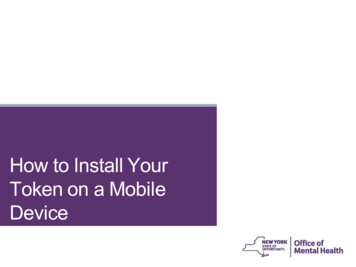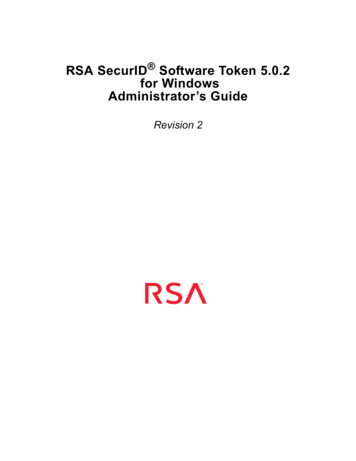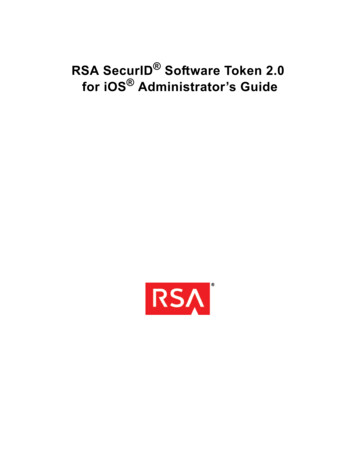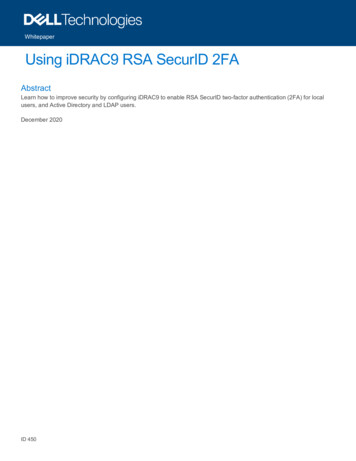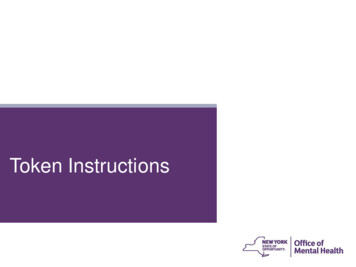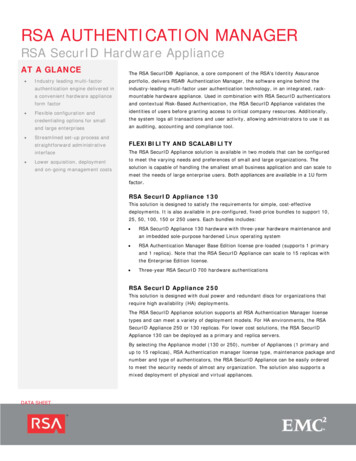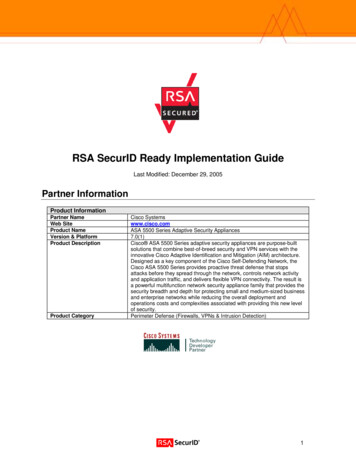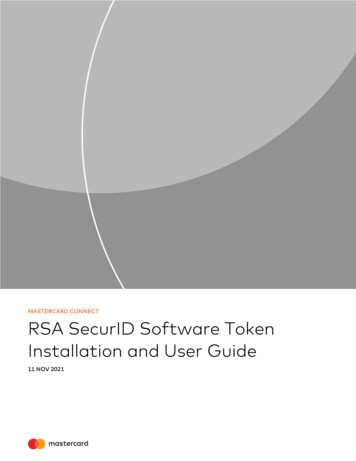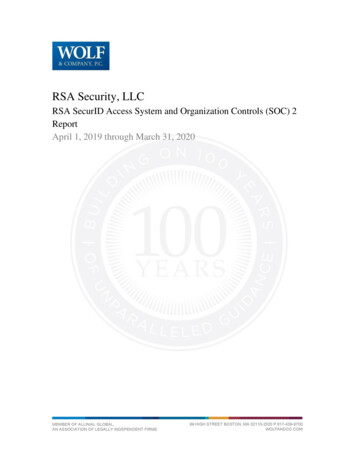
Transcription
RSA Security, LLCRSA SecurID Access System and Organization Controls (SOC) 2ReportApril 1, 2019 through March 31, 2020
TABLE OF CONTENTSI.RSA SECURITY, LLC’S ASSERTION . 1II.INDEPENDENT SERVICE AUDITOR’S REPORT . 3III.DESCRIPTION OF RSA’S SECURID ACCESS SYSTEM . 8IV.INDEPENDENT SERVICE AUDITOR’S DESCRIPTION OF TESTS OF CONTROLSAND RESULTS . 29A. INTRODUCTION . 29B. APPLICABLE TRUST SERVICES CRITERIA . 29C. TESTING OF OPERATING EFFECTIVENESS . 30V.ADDITIONAL INFORMATION PROVIDED BY RSA SECURITY, LLC . 73CONTROL EXCEPTIONS AND RSA SECURITY, LLC’S MANAGEMENT RESPONSES . 73
I.RSA SECURITY, LLC’S ASSERTIONWe have prepared the accompanying description titled “Description of RSA’s SecurID Access System”throughout the period April 1, 2019 to March 31, 2020 (description) based on the criteria for a description of aservice organization’s system in DC section 200, 2018 Description Criteria for a Description of a ServiceOrganization’s System in a SOC 2 Report (AICPA. Description Criteria) (description criteria). The descriptionis intended to provide report users with information about the system that may be useful when assessing the risksarising from interactions with RSA Security, LLC’s system, particularly information about system controls thatRSA Security, LLC has designed and implemented to provide reasonable assurance that its service commitmentsand system requirements were achieved based on the trust services for security, availability, and confidentiality(applicable trust services criteria) set forth in TSP section 100, 2017 Trust Services Criteria for Security,Availability, Processing Integrity, Confidentiality, and Privacy, (AICPA, Trust Services Criteria).RSA Security, LLC uses subservice organizations to support the operations of the system. The subserviceorganization Microsoft Azure provides cloud infrastructure services while the subservice organizations IronMountain and Equinix provide data center services. The description indicates that complementary subserviceorganization controls that are suitably designed and operating effectively are necessary, along with controls atRSA Security, LLC, to achieve RSA Security, LLC’s service commitments and system requirements based onthe applicable trust services criteria. The description presents RSA Security, LLC’s controls, the applicable trustservices criteria, and the types of complementary subservice organization controls assumed in the design of RSASecurity, LLC’s controls. The description does not disclose the actual controls at the subservice organizations.The description discusses that materials are gathered and reviewed during the third party selection process tounderstand the risks associated with third party relationship. However, during the period of April 1, 2019 throughMarch 31, 2020 RSA Security, LLC did contract not new subservice organizations for the SecurID AccessSystem that would warrant the operation of the control for the following trust service criteria: CC3.4 COSOPrinciple 9: The entity identifies and assesses changes that could significantly impact the system of internalcontrol and CC9.2 The entity assesses and manages risks associated with vendors and business partners.Additionally, the description discusses that RSA Security, LLC will provide a notification to customers at leasttwenty-four (24) hours prior to any emergency downtime event. However, during the period of April 1, 2019through March 31, 2020 RSA Security, LLC did not have any emergency downtime events that warrant theoperation of the control for the following trust service criterion: COSO Principle 15: The entity communicateswith external parties regarding matters affecting the functioning of internal control.1
We confirm, to the best of our knowledge and belief, that:a. the description presents RSA Security, LLC’s system that was designed and implemented throughoutthe period April 1, 2019 to March 31, 2020, in accordance with the description criteria.b. the controls stated in the description were suitably designed throughout the period April 1, 2019 toMarch 31, 2020, to provide reasonable assurance that RSA Security, LLC’s service commitmentsand system requirements would be achieved based on the applicable trust services criteria, if itscontrols operated effectively throughout that period, and if the subservice organizations applied thecomplementary controls assumed in the design of RSA Security, LLC’s controls throughout thatperiod.c. the controls stated in the description operated effectively throughout the period April 1, 2019 toMarch 31, 2020, to provide reasonable assurance that RSA Security, LLC’s service commitmentsand system requirements were achieved based on the applicable trust services criteria, ifcomplementary subservice organization controls assumed in the design of RSA Security, LLC’scontrols operated effectively throughout that period.2
II. INDEPENDENT SERVICE AUDITOR’S REPORTTo: RSA Security, LLCScopeWe have examined RSA Security, LLC’s (RSA’s or the Company’s) accompanying description of its systemtitled "Description of RSA’s SecurID Access System" throughout the period April 1, 2019 to March 31, 2020(description) based on the criteria for a description of a service organization’s system in DC section 200, 2018Description Criteria for a Description of a Service Organization’s System in a SOC 2 Report (AICPA,Description Criteria), (description criteria) and the suitability of the design of controls stated in the descriptionthroughout the period April 1, 2019 to March 31, 2020, to provide reasonable assurance that RSA’s servicecommitments and system requirements were achieved based on the trust services criteria relevant to security,availability, and confidentiality (applicable trust services criteria) set forth in TSP section 100, 2017 TrustServices Criteria for Security, Availability, Processing Integrity, Confidentiality, and Privacy (AICPA, TrustServices Criteria).RSA uses subservice organizations to support the operations of the system. The subservice organizationMicrosoft Azure provides cloud infrastructure services while the subservice organizations Iron Mountain andEquinix provide data center services. The description indicates that complementary subservice organizationcontrols that are suitably designed and operating effectively are necessary, along with controls at RSA, to achieveRSA’s service commitments and system requirements based on the applicable trust services criteria. Thedescription presents RSA’s controls, the applicable trust services criteria, and the types of complementarysubservice organization controls assumed in the design of RSA’s controls. The description does not disclose theactual controls at the subservice organizations. Our examination did not include the services provided by thesubservice organizations, and we have not evaluated the suitability of the design or operating effectiveness ofsuch complementary subservice organization controls.The information included in Section V, "Additional Information Provided by RSA Security, LLC" is presentedby RSA’s management to provide additional information and is not a part of the description. Informationcontained in Section V has not been subjected to the procedures applied in the examination of the description, thesuitability of the design of controls, and the operating effectiveness of the controls to achieve RSA’s servicecommitments and system requirements based on the applicable trust services criteria, and accordingly, weexpress no opinion on it.3
Service Organization’s ResponsibilitiesRSA is responsible for its service commitments and system requirements and for designing, implementing, andoperating effective controls within the system to provide reasonable assurance that RSA’s service commitmentsand system requirements were achieved. RSA has provided the accompanying assertion titled "RSA Security,LLC’s Assertion" (assertion) about the description and the suitability of design and operating effectiveness ofcontrols stated therein. RSA is also responsible for preparing the description and assertion, including thecompleteness, accuracy, and method of presentation of the description and assertion; providing the servicescovered by the description; selecting the applicable trust services criteria and stating the related controls in thedescription; and identifying the risks that threaten the achievement of the service organization’s servicecommitments and system requirements.Service Auditor’s ResponsibilitiesOur responsibility is to express an opinion on the description and on the suitability of design and operatingeffectiveness of controls stated in the description based on our examination. Our examination was conducted inaccordance with attestation standards established by the American Institute of Certified Public Accountants(AICPA) and in accordance with International Standard on Assurance Engagements 3000 (Revised), AssuranceEngagements Other Than Audits or Reviews of Historical Financial Information, issued by the InternationalAuditing and Assurance Standard Board. Those standards require that we plan and perform our examination toobtain reasonable assurance about whether, in all material respects, the description is presented in accordancewith the description criteria and the controls stated therein were suitably designed and operated effectively toprovide reasonable assurance that the service organization’s service commitments and system requirements wereachieved based on the applicable trust services criteria. We believe that the evidence we obtained is sufficient andappropriate to provide a reasonable basis for our opinion.An examination of the description of a service organization’s system and the suitability of the design andoperating effectiveness of controls involves the following: Obtaining an understanding of the system and the service organization’s service commitments andsystem requirementsAssessing the risks that the description is not presented in accordance with the description criteria andthat controls were not suitably designed or did not operate effectivelyPerforming procedures to obtain evidence about whether the description is presented in accordance withthe description criteriaPerforming procedures to obtain evidence about whether controls stated in the description were suitablydesigned to provide reasonable assurance that the service organization achieved its service commitmentsand system requirements based on the applicable trust services criteriaTesting the operating effectiveness of controls stated in the description to provide reasonable assurancethat the service organization achieved its service commitments and system requirements based on theapplicable trust services criteriaEvaluating the overall presentation of the description4
Our examination also included performing such other procedures as we considered necessary in thecircumstances.Service Auditor’s Independence and Quality ControlWe have complied with the independence and other ethical requirements of the Code of Professional Conductestablished by the AICPA.We applied the Statements on Quality Control Standards established by the AICPA and, accordingly, maintain acomprehensive system of quality control.Inherent LimitationsThe description is prepared to meet the common needs of a broad range of report users and may not, therefore,include every aspect of the system that individual users may consider important to meet their informationalneeds.There are inherent limitations in the effectiveness of any system of internal control, including the possibility ofhuman error and the circumvention of controls.Because of their nature, controls may not always operate effectively to provide reasonable assurance that theservice organization’s service commitments and system requirements are achieved based on the applicable trustservices criteria. Also, the projection to the future of any conclusions about the suitability of the design andoperating effectiveness of controls is subject to the risk that controls may become inadequate because of changesin conditions or that the degree of compliance with the policies or procedures may deteriorate.Description of Tests of ControlsThe specific controls we tested and the nature, timing, and results of those tests are listed in section IV.5
Controls Did Not Operate During the Period Covered by the ReportThe description discusses that materials are gathered and reviewed during the third party selection process tounderstand the risks associated with third party relationship. However, during the period of April 1, 2019 throughMarch 31, 2020 RSA Security, LLC did not contract new subservice organizations for the SecurID AccessSystem that would warrant the operation of the control for the following trust service criteria: CC3.4 COSOPrinciple 9: The entity identifies and assesses changes that could significantly impact the system of internalcontrol and CC9.2 The entity assesses and manages risks associated with vendors and business partners.Additionally, the description discuses that RSA Security, LLC will provide a notification to customers at leasttwenty-four (24) hours prior to any emergency downtime event. However, during the period of April 1, 2019through March 31, 2020 RSA Security, LLC did not have any emergency downtime events that warrant theoperation of the control for the following trust service criterion: COSO Principle 15: The entity communicateswith external parties regarding matters affecting the functioning of internal control.OpinionIn our opinion, in all material respects,a. the description presents RSA’s system that was designed and implemented throughout the periodApril 1, 2019 to March 31, 2020, in accordance with the description criteria.b. the controls stated in the description were suitably designed throughout the period April 1, 2019 toMarch 31, 2020, to provide reasonable assurance that RSA’s service commitments and systemrequirements would be achieved based on the applicable trust services criteria, if its controls operatedeffectively throughout that period and if the subservice organizations applied the complementarycontrols assumed in the design of RSA’s controls throughout that period.c. the controls stated in the description operated effectively throughout the period April 1, 2019 toMarch 31, 2020, to provide reasonable assurance that RSA’s service commitments and systemrequirements were achieved based on the applicable trust services criteria, if complementarysubservice organization controls assumed in the design of RSA’s controls operated effectivelythroughout that period.6
Restricted useThis report, including the description of tests of controls and results thereof in section IV, is intended solely forthe information and use of RSA, user entities of RSA’s system during some or all of the period April 1, 2019 toMarch 31, 2020, business partners of RSA subject to risks arising from interactions with the system, practitionersproviding services to such user entities and business partners, prospective user entities and business partners, andregulators who have sufficient knowledge and understanding of the following: The nature of the service provided by the service organizationHow the service organization’s system interacts with user entities, business partners, subserviceorganizations, and other partiesInternal control and its limitationsComplementary subservice organization controls and how those controls interact with the controls at theservice organization to achieve the service organization’s service commitments and system requirementsUser entity responsibilities and how they may affect the user entity’s ability to effectively use the serviceorganization’s servicesThe applicable trust services criteriaThe risks that may threaten the achievement of the service organization’s service commitments andsystem requirements and how controls address those risksThis report is not intended to be, and should not be, used by anyone other than these specified parties.Boston, MAMay 7, 20207
III. DESCRIPTION OF RSA’S SECURID ACCESS SYSTEMOVERVIEW OF OPERATIONSCompany BackgroundFounded in 1982, RSA Security, LLC (RSA or the Company) is a global provider of security solutions forbusiness acceleration that helps organizations manage their complex and sensitive security challenges. RSA'stechnology, business, and industry solutions, coupled with professional services and dozens of strategic thirdparty partnerships, help organizations bring trust to user identities, the activities that they perform, and the datathat is generated.Description of Services ProvidedRSA SecurID Access uses risk analytics and context-based awareness of users to provide authentication usinga variety of authentication methods, including token-less authentication and biometrics. RSA SecurID Accessgives your organization the confidence that people are who they say they are, while providing an enhancedsecurity experience.RSA SecurID Access delivers the following key capabilities organizations are looking for: Multi-factor Authentication – RSA SecurID Access offers convenient access and security with abroad range of multi-factor authentication (MFA) methods from traditional RSA SecurID hardware andsoftware tokens to mobile and biometric options. Access Management – RSA SecurID Access enforces access policies for over five hundred (500)applications out-of-the-box, ensuring security is continuously enforced while making sure appropriateaccess is available for all users, from any device, to any application. Single sign-on (SSO) is availableand supports integration with cloud, mobile, and web applications. Risk Analytics – RSA SecurID Access applies risk-based analytics and context-aware insights toenable smarter access decisions at the access request point of entry. By analyzing data about the users,their activity and environment, and applications, RSA SecurID Access provides organizations thenecessary identity intelligence that minimizes risk and improves overall security posture.8
PRINCIPAL SERVICE COMMITMENTS AND SYSTEM REQUIREMENTSRSA designs its processes and procedures related to the RSA SecurID Access system to meet its objectives forits SecurID Access system. Those objectives are based on the service commitments that RSA makes to userentities, the laws and regulations that govern the provision of the RSA SecurID Access system, and thefinancial, operational, and compliance requirements that RSA has established for the services. The RSASecurID Access system is subject to the relevant regulatory and industry information and data securityrequirements in which RSA operates.Security, availability, and confidentiality commitments to user entities are documented and communicated incustomer contracts and the public facing website. The principal security, availability, and confidentialitycommitments are standardized and include, but are not limited to, the following:Security Built-in security capabilities utilizing security technology for authentication, authorization,accountability, encryption, and key management, which integrate with customer environments and helpcustomers meet their security objectives and compliance requirements. Secure software development process to ensure that security goes across policy, people, processes, andtechnology.Confidentiality Dedicated product security incident response team that follows industry best practices in managing andresponding to security vulnerabilities to minimize customers’ risk of exposure.Availability Uptime service levels of 99.9%.RSA establishes operational requirements that support the achievement of the principal service commitments,relevant laws and regulations, and other system requirements. Such system requirements include the use ofencryption technologies to protect system user data both at rest and in transit; monitoring of production systemsfor performance metrics and system anomalies; database backup and recovery test processes; and necessarysystem change management procedures to support the requisite authorization, documentation, testing, andapproval of system changes.Such requirements are communicated in RSA’s policies and procedures, system design documentation, andcontracts with customers. Information security policies define an organization-wide approach to how systemsand data are protected. These include policies around how the service is designed and developed, how thesystem is operated, how the internal business systems and networks are managed and how employees are hired,trained, and managed. In addition to these policies, standard operating procedures have been documented onhow to carry out specific manual and automated processes required in the operation and development of theRSA SecurID Access system.9
In accordance with the assertion and the description criteria, the aforementioned service commitments andrequirements are those principal service commitments and requirements common to the broad base of users ofthe system and may, therefore, not fully address the specific service commitments and requirements made to allsystem users, in each individual case.COMPONENTS OF THE SYSTEM USED TO PROVIDE THE SERVICEInfrastructure and SoftwareInfrastructureThe RSA SecurID Access production infrastructure resides in Microsoft Corporation’s (Microsoft) AzureInfrastructure-as-a-service (IaaS) cloud environment. For high availability and infrastructure resilience, theproduction infrastructure is hosted in and distributed across six (6) Azure data center regions within the UnitedStates (US), Europe, and Asia Pacific: East US (Virginia), West US (California), West Europe (Netherlands),North Europe (Ireland), Australia Central (Canberra), and Australia Central 2 (Canberra). East US is the primaryregion in the US, with West US serving as the secondary geo-data backup location. West Europe is the primaryregion in Europe, with North Europe serving as the secondary geo-data backup location. Australia Central is theprimary region in Australia, with Australia Central 2 serving as the secondary geo-data backup location.The production Azure SQL database servers are backed up at least daily via point-in-time snapshots forcontinuous database redundancy between the primary (East US, West Europe, Central Australia) and secondary(West US, North Europe, and Central Australia 2) Azure data center regions. Production data in the Azure cloudis stored in an encrypted-at-rest state and is transmitted over a private connection utilizing transport layersecurity (TLS) encryption protocol, which is not accessible by the public internet. The Azure cloudinfrastructure (e.g. production servers, virtual machines, databases) is provisioned and managed via the Azuremanagement portal user interfaces (UIs).In order to access the production environment from the back-end, RSA SaaS Operations administrators arerequired to first authenticate to a virtual desktop infrastructure (VDI) via MFA. The VDI and Active Directory(AD) domain controller servers are hosted within the data centers owned by Equinix, Inc. (Equinix) in Billerica,Massachusetts (primary) and Iron Mountain Information Management, LLC (Iron Mountain) in Phoenix,Arizona (secondary).10
The in-scope infrastructure consists of multiple applications, operating system platforms and databases, asshown in the table below:Primary InfrastructureProductionApplicationBusiness Function DescriptionOperatingSystemPlatformADAD is a Windows directory service controllingauthentication and access to the SecurID network.VDIProvide access control, endpoint security, and multifactor authentication and authorization services to theAzure production environment.Virtual DesktopApplicationServers, WebServers, andVirtualMachinesProduction application and web servers and virtualmachines supporting the SecurID identity and accessmanagement system.SUSE LinuxEnterpriseServer (SLES)12DatabasesProduction databases supporting the SecurID identityand access management system.AzureManagementPortalManagement portal UI where information technology(IT) personnel have the ability to configure, manage,and monitor the cloud infrastructure supporting theSecurID identity and access management systemwithin the Azure environment.NetworkSecurityGroups (NSGs)NSGs contain security rules that allow or denyinbound network traffic to, or outbound networktraffic from, several types of Azure resources.PhysicalLocationIron husetts)WindowsAzure VirtualMySQL ServerAzure VirtualMySQL ServerSUSE LinuxEnterpriseServer (SLES)12Azure DataCenters (East US,West US, WestEurope, NorthEurope, AustraliaCentral, andAustralia Central2)Microsoft AzureSoftwareThe following programs and software are utilized in support of the delivery of RSA’s services: Advanced Intrusion Detection Environment (AIDE) – A file integrity monitoring tool is utilized tomonitor for changes made to in-scope systems which also functions as the intrusion detection systemand malware detection software. Elasticsearch, Logstash, Kibana (ELK) Stack– A log consolidation, visualization, and monitoringsolution. Qualys Enterprise – An external vulnerability scanner.11
Zabbix – An enterprise monitoring software utilized to monitor the availability and health of theproduction infrastructure. Pingdom – An enterprise monitoring application supporting the customer-facing status page utilized tomonitor the availability and service disruption of the authentication and administrator console. JIRA – A ticketing system utilized to centrally track incidents and changes. GitHub – A version control software to manage and restrict the ability to access and modify applicationcode. Virtual Private Network (VPN) – An encrypted connection to allow remote access to the productionenvironment.PeopleThe following functional areas of operations are used to support the RSA SecurID Access system: Executive Management – Responsible for overseeing corporate and business unit activities, settinggoals, and overseeing objectives. Human Resources (HR) – Responsible for HR practices and process including onboarding,termination, employee relations, compensation, and benefits. RSA SaaS Operations – Responsible for designing, implementing, and maintaining the RSA SaaSofferings. RSA Development / Engineering – Responsible for administering the systems development life cycle(SDLC) for the RSA offerings. Chief Technology Officer (CTO) Team – Responsible for investigating fraud-related incidentsreported by customers, providing insights into the risk assessment process, and defining the future riskmodels.12
ProceduresAccess ControlAccess Authentication and AuthorizationAuthentication to the RSA SecurID Access production environment is restricted via multiple, layered securitymechanisms. RSA SaaS Operations users accessing the production environment from the back-end must firstauthenticate via two-factor authentication utilizing encrypted VDI. Once authenticated, access to productionoperating systems and databases within the Azure cloud is restricted via a username and password to authorizedpersonnel via the operations console. In order to access Azure management portal from the front-end, usersauthenticate via Azure MFA. Firewalls (NSGs) are managed and configured through the Azure managementportal UI.RSA utilizes predefined security groups to assign role-based access privileges and segregate access to data forthe in-scope systems. Administrative access privileges within the VMware Horizon VDI and the operationsconsole, which provides access to the Azure production infrastructure from the back-end and access to theAzure management portal from the front-end, are restricted to user accounts accessible by authorized personnel.Access Requests and Access RevocationAccess to information systems is required to be based on operational and security requirements. A documentedprocess is in place for granting internal and external user access, provisioning approved additions access rights,and reviewing access of existing account holders. User access reviews, including a review of privileged useraccess rights, are performed quarterly to help ensure that access to data is restricted. Upon termination ofpersonnel, RSA SaaS Operations personnel revoke user access privileges assigned to the terminated personnel.Change ManagementRSA has implemented change management policies and procedures that outline that change managementseparation of duties such that authorization, development, testing, and implementation are segmented functionswithin the process. A change request is a formal proposal for a change to be made, in the form of a Jira changecontrol board (CCB) ticket and includes details of the proposed change and back-out procedures to allow forrollback of changes when changes impair system operation. Changes documented within the Jira automatedticketing system include both application code changes as well as operating system patches and upgrades. Theprocess starts when the need for a change has been identified by a customer, business stakeholder, RSA SaaSOperations team member, or a security concern. Changes are often triggered by an incident, problem, or
RSA Security, LLC, to achieve RSA Security, LLC's service commitments and system requirements based on the applicable trust services criteria. The description presents RSA Security, LLC's controls, the applicable trust services criteria, and the types of complementary subservice organization controls assumed in the design of RSA
